PIONEER DDJ-RR

INSTALLATION
Firmware & Drivers
Drivers
For both Windows & Mac OSX computers:
Install the necessary drivers from https://www.pioneerdj.com/en/support/software/ddj-rr/#drivers
Firmware
Update the firmware to the latest available version https://www.pioneerdj.com/en/support/software/ddj-rr/#firmware-update
.
VirtualDJ 8 Setup
Once VirtualDJ 8 is launched, a Login Window will appear. Login with your virtualdj.com account credentials.
A Pro Infinity or a Pro Subscription License is required to use the Pioneer DDJ-RR. Without any of the previously mentioned Licenses, the controller will operate for 10 minutes each time you restart VirtualDJ.
http://www.virtualdj.com/buy/index.html

Click on the "Use Soundcard" button if your speakers are connected to the Master Output of the DDJ-RR.
Click OK.

The unit is now ready to operate.
Midi Operation
The factory default Mapping offers the functions described in this Manual, however those can be adjusted to your needs via VDJ Script actions.
Find more details at http://www.virtualdj.com/wiki/VDJ8script.html
Notice that the unit will appear twice in the list. The second entry refers to the HID protocol and holds the mapping for the Jogs, Volume faders, and Crossfader. The HID protocol is offered when the unit is set to the "rekordbox" mode. See details in Settings
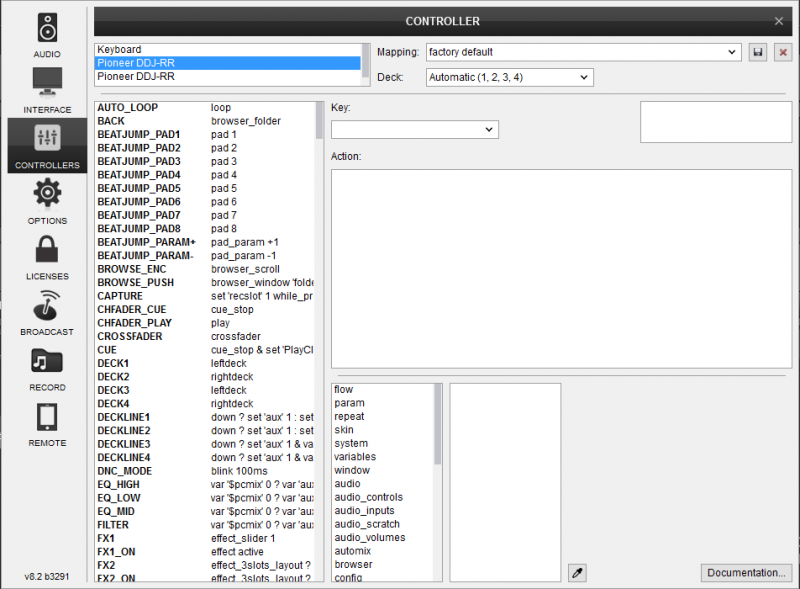
Audio Setup
Timecode (DVS)* configuration is also available (see DVS Support ).
*requires Pro Infinity or Timecode License http://www.virtualdj.com/buy/index.html
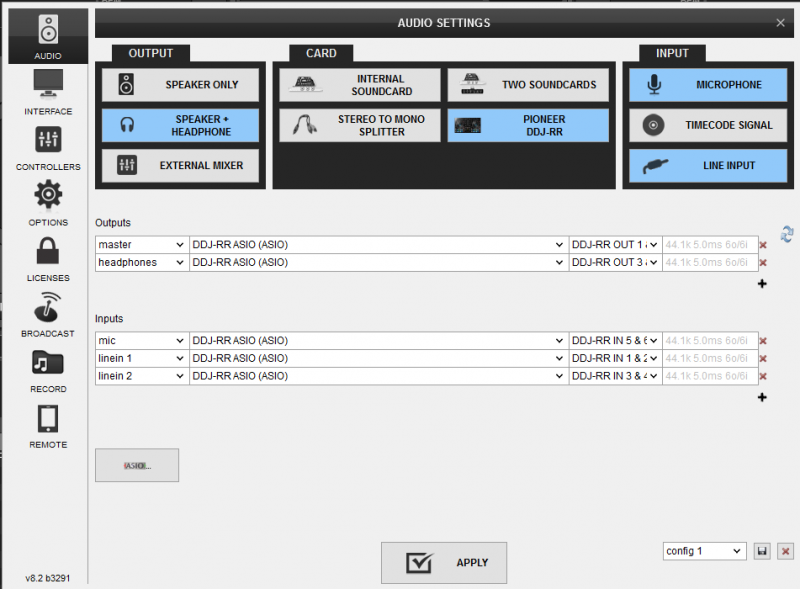
For further software settings please refer to the User Guide of VirtualDJ 8.
http://www.virtualdj.com/manuals/virtualdj8/index.html
LAYOUT
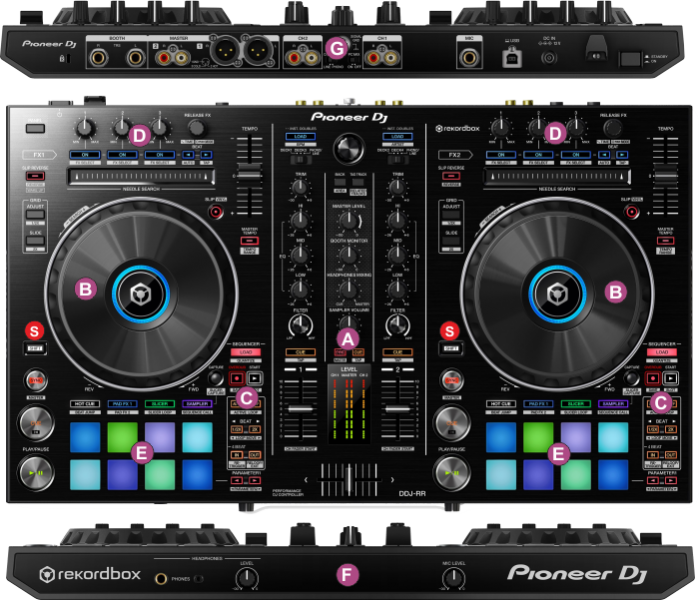
The functionality of each button, knob and connection per section (as shown in the image above) will be explained in detail in the next chapters
A. Mixer Controls
B. Deck Controls
C. Loop Controls
D. Effects
E. Pads
F. Front panel
G. Rear panel
MIXER
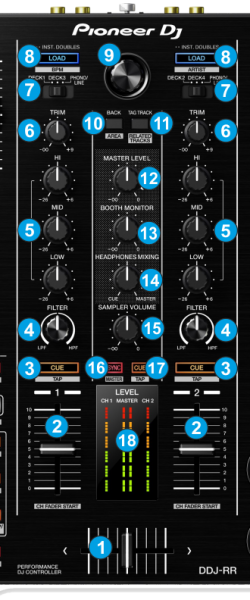
- CROSSFADER: Blends audio between the left and right assigned channels.
- VOLUME: Alter the output Volume of the left/right selected software Deck, depending on the (7) Deck Selectors. While SHIFT is held down, the VOLUME faders will stop the deck at the previously selected Cue point when these reach the minimum level (zero) and will start the deck (synced to the other deck) if those move from the zero position. (Fader Start)
- PFL. Press this button to send this channel's pre-fader signal to the Headphones Channel for monitoring. When engaged, the button will be lit. Cued deck depends on the (7) Deck Selectors.
Hold SHIFT down and then use these buttons to manually tap the tempo of the loaded track. - FILTER. Applies a High Pass/Low Pass Filter on the left/right selected deck(middle position is Off position).
- EQ (Low/Mid/Hi) Adjust the low/middle/high (bass/mid/trebble) frequencies of the selected left or right software deck.
- TRIM: Adjusts the pre-fader output level (gain) of the corresponding software deck.
- DECK SELECT: Use these switches to select the Left/Right deck or route the corresponding Input to the left/right mixer channel. When the left switch is set to Deck 1/3, the left side of the DDJ-RR will control VirtualDJ Deck 1/3. When the right switch is set to Deck 2/4, the right side of the DDJ-RR will control VirtualDJ Deck 2/4.
The behavior of the left/right side of the DDJ-RR when the switches are set to Phone/Line depends on the PCMIX switch (rear side) and is explained in details in the Inputs section. - LOAD: Press one of these buttons while a track is selected to load it to left Deck (1 or 3) or right Deck (2 or 4) respectively, depending on the Deck Selectors (7). Press and hold the same button for more than 1 second, to unload the same deck.
Hold SHIFT down and then use the left LOAD button to sort the tracks of the Songs list by BPM (toggles between descending and ascending order).
Hold SHIFT down and then use the right LOAD button to sort the tracks of the Songs list by Artist (toggles between descending and ascending order). - BROWSE Knob/push :
Knob: Scrolls through files or folders. When SHIFT is pressed it scrolls faster (+/- 15 tracks/folders)
Push: If focus is on the Folders list, anf the folder contains tracks, enters the Songs List. If the folder doesnt contain tracks, opens its subfolders and selects the 1st available. If focus is on the Songs list, moves back to the Folders list.
Hold SHIFT down and then push the BROWSE knob to toggle between the Normal and Zoomed Browser view - BACK: Set focus to Folders list. If focus is on the Folders list, use this button to open/close sub-folders.
Hold SHIFT down and then use this button to cycle focus through the available Browser windows (Folders, Songs, SideView). - TAG TRACK: Adds the selected track of the Songs List to the selected SideView List (Automix, Karaoke, Sidelist). When SHIFT is pressed, it cycles through the available view of Sideview (Automix, Sidelist, Sampler, Karaoke, Clone views)
- MASTER VOLUME : Adjusts the Master Output Volume (Hardware operation - not visible on VirtualDJ GUI)
- BOOTH MONITOR : Adjusts the Output Volume of the Booth Output (Hardware operation - not visible on VirtualDJ GUI)
- HEADPHONES MIX: Blends audio signal in Headphones between the PFLed decks and the Master Output. When the knob is at the minimum left position, only decks that have the PFL turned on will b routed in Headphones. When the knob is at the maximum right position, only the Master Output audio signal will be routed in Headphones..
- SAMPLER VOLUME: Adjusts the Master Volume of the Sampler.
- SAMPLER SYNC: Use this button to link Video Crossfader with the Audio crossfader (the Video Crossfader will follow the position of the Audio Crossfader).
Hold SHIFT down and use this button to set the Video Crossfader to Auto. When enabled, the video crossfader will move automatically depending on which deck is played out in Master. - SAMPLER CUE: If turned off, the Sampler will be outputted only through the Master Output. If turned on the Sampler will be heard through Headphones as well.
- LEVEL METERS VIEW: The middle LEDs indicate the overall Output level of the Master Output. The left and right LEDs will indicate the pre-fader output volume of the left-right selected deck.
Decks
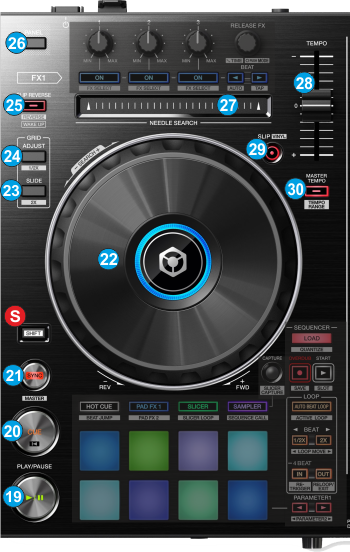
S. SHIFT: The SHIFT button if held offers additional functionality to several buttons/knobs.
- PLAY: Play/Pauses the track. Hold SHIFT and then press this button to play the track in Stutter mode (while pressed)
- CUE: When the Deck is paused, you can set a temporary Cue Point by moving the Platter to place the Audio Pointer at the desired location and then pressing the Cue Button. During playback, you can press the Cue Button to return the track to this Cue Point. (If you did not set a Cue Point, then it will return to the beginning of the track.). If the Deck is paused, you can press and hold the Cue Button to play the track from the Temporary Cue Point. Releasing the Cue Button will return the track to the temporary Cue Point and pause it. To continue playback without returning to the Temporary Cue Point, press and hold the Cue Button, then press and hold the Play Button, and then release both buttons.
Hold SHIFT and then press this button to return to the beginning of the track - SYNC: Syncs the deck with the opposite one. Hold SHIFT and then press this button to set the deck as Master Deck. Using 4 decks skins, all other decks will sync to the Master Deck.
- JOG: Touch sensitive platter for scratching (vinyl mode) or bending (CD Mode). Hold SHIFT and use the JOG in Seek (Search) mode.
The LED ring will be colored depending on the selected deck (blue for deck 1, red for deck 2, green for deck 3 and orange for deck 4). A different color indication can be selected via the Settings Pad page. See further details in the Settings chapter - GRID SLIDE: Hold this button down and then use the Jogwheel (22) to slide the Beat Grid (CBG) of the track to left or right.
Hold SHIFT down and then use this button to double the BPM value of the track. - GRID ADJUST: Hold this button down to set the current track's position as First-Beat Anchor and then use the Jogwheel (22) to fine-adjust the BPM of the track.
Hold SHIFT down and then use this button to half the BPM value of the track. - SLIP REVERSE: Press and keep this button down to play the track in reverse. Once the button is released, the track will resume playing from the position it would have been, if the reverse was never triggered (Censor)
Hold SHIFT down and then use this button to toggle between normal and reverse play.
The LED of the button will blink while the track is playing in reverse - PANEL (available only on the left side). Use this button to cycle through the center panels of the VirtualDJ GUI (MIXER, VIDEO, SCRATCH and MASTER).
Hold SHIFT down and then use this button to open/close the Browser Sideview - NEEDLE SEARCH : Use this touch-strip to navigate though the track (seek). When track is playing out in Master (audible), the Touchstrip will not function, protecting accidental touch while reaching near a different button/knob.
Hold SHIFT and then use the touchstrip to navigate through the track regardless its playing/audible status. - PITCH FADER : Adjusts the Tempo of the track
- SLIP: Enables Slip Mode on each deck. Several software functions (such as Jogwheel movements, HotCues and Loops) will apply temporary on the track, and the track will return to the position it would have been when those functions are not triggered.
Hold SHIFT down and then use this button to toggle between the CD (Bend) and Vinyl (Scratch) modes for the Jogwheel - MASTER TEMPO: Press this button to enable/disable the Master Tempo (Key Lock) of the deck.
Hold SHIFT down and then press this button to select the next one of the available Pitch ranges for the PITCH/Tempo Slider.
LOOPS
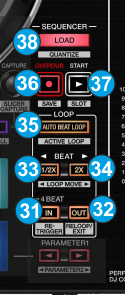
- LOOP IN : Use this button to set the Loop In point (entry) for a manual loop. When a loop is enabled, use this button to enable/disable the Loop In Adjust mode and then use the Jogwheel to fine-adjust the Loop In point.
Hold SHIFT and then use this button to enable the last triggered loop (reloop)
Hold the button for more than 1 second to trigger a 4 Beats Loop - LOOP OUT : Use this button to set the Loop Out point (exit) for a manual loop. When a loop is enabled, use this button to enable/disable the Loop Out Adjust mode and then use the Jogwheel to fine-adjust the Loop Out point.
Hold SHIFT and then use this button to enable/disable the last triggered loop (reloop/exit) - LOOP HALF. Use this button to half the size of the Loop in beats.
When Loop is enabled, hold SHIFT and then use this button to move the Loop 1 beat backwards - LOOP DOUBLE. Use this button to double the size of the Loop in beats.
When Loop is enabled, hold SHIFT and then use this button to move the Loop 1 beat forward - AUTO BEAT LOOP. Use this button to enable/disable an Auto Loop of the selected size in beats
- SEQ OVERDUB. Use this button to store the current loop to the default Saved Loop slot.
Hold SHIFT down and then use this button to delete the Saved Loop from the slot - SEQ START. Use this button to enable/disable the Saved Loop. The track will not jump to the position of the Saved Loop if later to the current track's position (Load & Prepare)
Hold SHIFT down and then use this button to trigger the Saved Loop and jump to its position (Load & Jump) - SEQ LOAD. Use this button to link all pitch faders (Pitch Lock). When enabled, moving one Pitch fader, will also move the software pitch faders at the same amount.
Hold SHIFT down and then use this button to enable/disable Smart Cue. When enabled, the Hotcues will be triggered quantized to the nearest beat
EFFECTS

Each one of the left/right FX unit offers 2 modes. The Single Effects mode offers one effect slot but more parameters controls per effect. The Multi Effects mode offers 3 effect slots (to trigger more than 1 effect at the same time – chained effects). The selection between those 2 modes is done by pressing the BEAT < (45) button while SHIFT is held.
Single FX mode
Hold SHIFT down and then use the BEATS < (45) button to select the Single FX mode in the default GUI. The Single FX mode is selected by default on first launch
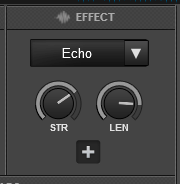

In this mode a single Effect is controlled with up to 6 Parameters and 3 Effect buttons. Only the first 2 Parameters are visible on the GUI. More Parameters and Effect buttons can be viewed in the FX GUI (opened from the + button on the GUI or using SHIFT+FX1 ON from the DDJ-RR)
- FX1 ON. Press this button to enable/disable the selected effect to the Left/Right selected deck.
Hold SHIFT down and then use this button, to open/close the FX GUI of the selected Effect. - FX2 ON. Press this button to select the previous effect from VirtualDJ Effects list. Hold SHIFT down and then use this button, to enable/disable the 1st effect button of the selected effect (if available).
- FX3 ON. Press this button to select the next effect from VirtualDJ Effects list.
Hold SHIFT down and then use this button, to enable/disable the 2nd effect button of the selected effect (if available). - FX1 knob. Controls the 1st effect parameter of the selected effect.
Hold SHIFT down to control the 4th effect parameter of the selected effect (if available). - FX2 knob. Controls the 2nd effect parameter of the selected effect.
Hold SHIFT down to control the 5th effect parameter of the selected effect (if available). - FX3 knob. Controls the 3rd effect parameter of the selected effect.
Hold SHIFT down to control the 6th effect parameter of the selected effect (if available).
Multi FX mode
Hold SHIFT down and then use the BEATS < (45) button to select the Multi FX mode in the default GUI.
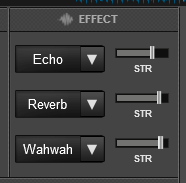

In this mode 3 different Effects can be applied and controlled with up to 2 Parameters for each FX slot. Only the first Parameter is visible on the GUI (and the 2nd Parameter while SHIFT is held on the DDJ-RR). More Parameters and Effect buttons can be viewed in the FX GUI (opened from the + button on the GUI or using SHIFT+FX1 ON from the DDJ-RR)
- FX1 ON. Press this button to enable/disable the selected effect of FX slot 1.
- FX2 ON. Press this button to enable/disable the selected effect of FX slot 2.
- FX3 ON. Press this button to enable/disable the selected effect of FX slot 3.
- FX1 knob. Controls the 1st parameter of the selected effect of FX slot 1.
Hold SHIFT to control the 2nd parameter of the selected effect of slot 1. - FX2knob. Controls the 1st parameter of the selected effect of FX slot 2.
Hold SHIFT to control the 2nd parameter of the selected effect of slot 2 - FX3 knob. Controls the 1st parameter of the selected effect of FX slot 3.
Hold SHIFT to control the 2nd parameter of the selected effect of slot 3.
OTHER FX KEYS
- BEATS < Press this button to decrease the value of the Beats for the selected Effect (in case the Effect offers such a feature).
Hold SHIFT down and then this button to toggle between the Single and Multi Effect modes. - BEATS > Press this button to increase the value of the Beats for the selected Effect (in case the Effect offers such a feature).
Hold SHIFT down and then use this button to manually tap the tempo of the track. - RELEASE knob. Use this knob to move the key of the track forward/backwards by 1 semitone.
Push the knob to reset the Key of the track to its original value
PADS
 The 8 RGB Pads offer various functions, depending on the selected Pad mode. Each of the 4 Pad mode buttons offers 2 individual modes (hold SHIFT and then press the PAD MODE button to access the additional mode). The modes represent a page of the PADS section on the default VirtualDJ GUI.
The 8 RGB Pads offer various functions, depending on the selected Pad mode. Each of the 4 Pad mode buttons offers 2 individual modes (hold SHIFT and then press the PAD MODE button to access the additional mode). The modes represent a page of the PADS section on the default VirtualDJ GUI.- PAD MODE. Press any of the 4 available Pad mode buttons to set the Pads to Hotcues, Loop Roll, Slicer or Sampler mode.
Hold SHIFT and then press any of the 4 available Pad mode buttons to set the Pads to BeatJump, Loop, Cue Loop and Remix Points mode. All 8 available Pad modes are explained in details in the next chapters - PADS. The 8 Pads offer different functionality depending on the selected mode. See next chapters for further details.
- PARAMETER. These buttons control the Parameters of the selected Pad mode.
- CAPTURE Hold this button down and then press one of the 8 Pads to record deck to a new sample in the Recording Bank. See Sampler mode for further details.
PADS - HOTCUES
Press the HOT CUE mode button to set the PADs to Hot Cue mode.
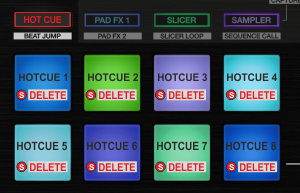

Each one of the 8 pad assigns a Hot Cue Point (1 to 8) or jumps the track to that Hot Cue Point (if assigned).
When a Hot Cue Button is unlit, you can assign a Hot Cue Point by pressing it at the desired point in your track. Once it is assigned, the Hot Cue Button will light on.
The color of the Pad depends on the setting nonColoredPOI or the assigned color from the POI Editor
Hold SHIFT and then press a pad to delete its assigned Hot Cue Point.
Use the PARAMETER buttons to jump the song to the previous/next assigned HotCue point.
Hold SHIFT and then use the PARAMETER buttons (31) to jump 1 beat backwards/forward.
Read further details about Pads in the VirtualDJ 8 manual
PADS - BEATJUMP
Hold SHIFT down and then press the HOT CUE mode button to set the Pads to Beat Jump mode
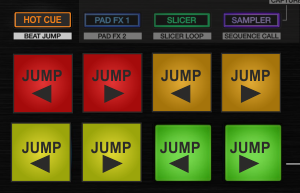
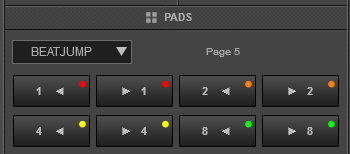
In this mode, the 8 Pads will jump the track backwards/forward by the amount of beats depending on the selected Beatjump page (from 1/8 beats to 32 Bars)
Use the PARAMETER buttons to select the Beatjump bank page (previous/next).
Read further details about Pads in the VirtualDJ 8 manual
PADS - LOOP ROLL
Press the PAD FX1 mode button to set the PADs to Loop Roll mode.
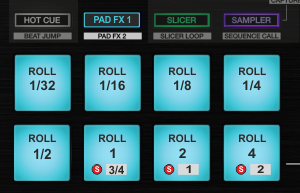
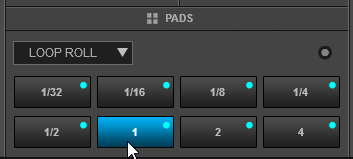
Press one of the 8 pads to trigger a momentary Loop Roll. Once the Pad is released, the track will resume playing from the position it would have been if the Loop Roll was never triggered. The exit point will be visible on the waveform of the VirtualDJ GUI with an additional “running” play marker.
Hold SHIFT to get a ½, ¾, 1 and 2 beats Loop Roll sizes for the 4 low pads.
Use the Page menu to apply the Loop Rolls to Video.
The PARAMETER buttons are not used in this mode.
Read further details about Pads in the VirtualDJ 8 manual
PADS - LOOPS
Hold SHIFT down and then press the PAD FX1 mode button to set the PADs to Loop mode.
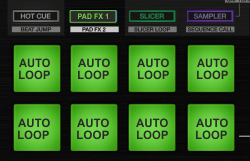

Press one of the pads to trigger an Auto Loop of a different size in beats, depending on the selected page. There are 6 different pages available with sizes starting from 1/32 up to 128 beats.
Use the PARAMETER buttons to select the previous/next page with the desired Loop sizes
Hold SHIFT and then use the PARAMETER buttons to change the behavior of the Loop pads, by selecting the On/Off (toggle), Hold (momentary – while pad is pressed) or the Roll mode (track will resume to the position it would have been once the pad is released)
Read further details about Pads in the VirtualDJ 8 manual
PADS - SLICER
Press the SLICER mode button to set the PADs to SLICER mode.
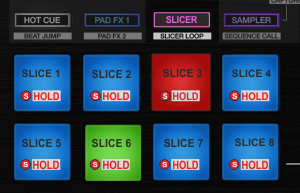
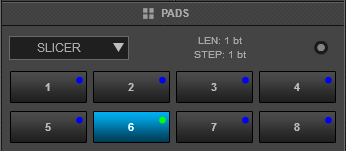
The 8 pads represent eight sequential beats—"Slices"—in the Beat Grid. The currently playing Slice is represented by the currently green lit pad. The light will move through the pads as it progresses through each eight-Slice phrase. Press a pad to repeat that Slice (hold it down if you want to keep looping it).
Once the Pad is released the track will continue to play from the position it would have been if the pad was never pressed.
Hold SHIFT and then use the Pads to repeat the memorized Slices (the Slices played/repeated last time)
Use the PARAMETER buttons to adjust the length of the Loop applied to the slice. Hold SHIFT down and then use the PARAMETER buttons to adjust the step of the Slices
Read further details about Pads in the VirtualDJ 8 manual
PADS - CUELOOP
Hold SHIFT and then press the SLICER mode button to set the PADs to Cue Loop mode.

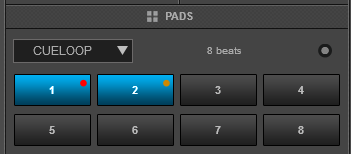
In this mode each one of the 8 pads assigns a Hot Cue Point or jumps the track to that Hot Cue Point, but in both cases, it also triggers a Loop at that point (momentary or toggle depending on the selected mode from the Page menu).
Hold SHIFT and then press a pad to stutter/jump to the Hotcue (loop will remain triggered)
Use the PARAMETER buttons to half/double the size of the triggered Loop.
Hold SHIFT and then use the PARAMETER buttons to select the On/Off (Toggle) or Hold (momentary) Loop trigger mode.
By default the Cue Loops will be quantized. This can be turned off/on from the Page Menu on the GUI.
Read further details about Pads in the VirtualDJ 8 manual
PADS - SAMPLER
Press the SAMPLER button to set the PADs to Sampler mode.
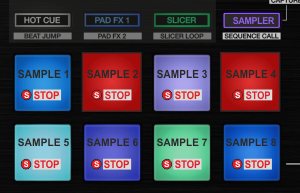

Each one of the 8 pads triggers a sample from the selected Sampler Bank of VirtualDJ. If a bank has less than 9 samples, both sides of the DDJ-RR will control the same samples. If a bank has more than 8 samples, the left side of the DDJ-RR will control samples 1 to 8 and the right side samples 9 to 16. The PAD will be lit if a sample slot is loaded and will blink if triggered.
Press the pads to trigger a sample. Depending on the selected trigger Pad mode, use SHIFT and the same pads to stop the sample.
Use the PARAMETER buttons to select the Sampler Bank (previous/next).
Hold SHIFT down and then the PARAMETER buttons to select the Trigger Pad mode (on/off, hold, stutter, unmute)
Read further details about Pads in the VirtualDJ 8 manual
PADS - REMIX POINTS
Hold SHIFT and then press the SAMPLER mode button to set the PADs to Remix Points mode.
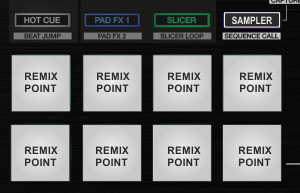
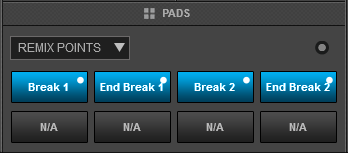
This mode offers the first 8 Remix Points of the loaded track. Remix Points are automatically defined from VirtualDJ, once the track is analyzed. Remix points can be managed from the POI Editor (more can be added/adjusted/deleted). They usually represent End/Start points of track’s blocks depending on the structure of the track and are always quantized when triggered.
The Remix points will be visible on the Song-position progress of the GUI (with white markers) once the Remix Points Pad page is selected.
FRONT PANEL

- HEADPHONES SOCKET Connect your Headphones for monitoring using the 1/4" or 3/4" socket
- HEADPHONES VOLUME. Adjust the Output Volume of the Headphones/Prelisten Channel
- MIC VOLUME. Adjust the Output volume of the Microphone Input (connection at the rear panel)
REAR PANEL

- BOOTH OUTPUT (TRS) Alternative Output for booth monitoring via 1/4" (TRS) cables. This Output is also part of the USB Audio Interface (Channels 5,6)
- MASTER OUTPUT (XLR/RCA). Main Output. Connect your amplifier or amplified speakers using common XLR cables or RCA cables. The Level of this Output is controlled from the top panel
- INPUTS 1 & 2. Connect your analogue media sources (CD, MP3 players etc). Inputs can be routed directly through the Master Output or through the DJ Application via the USB Audio Interface , depending on the selected Mixer mode. See details at the Inputs Chapter
- MIXER MODE. Select the Mixer operation mode. See details at the Inputs Chapter
- MIC INPUT. Connect your Microphone using a proper 1/4" cable/adapter The Volume of this Input is controlled from the Front panel. See further details about the Microphone Input in the Inputs Chapter
- USB. Connect the DDJ-RR with your computer via a USB port using the provided USB cable
- AC PLUG. Connect the provided AC/DC Power adapter.
- POWER. Power On/Off Switch. Power on the unit after all connections are done
RECORDING
No special configuration is required to record your mix with the DDJ-RR.
Simply open the MASTER center panel of the VirtualDJ GUI and click to the REC button (or BCAST for broadcasting) to record your mix.
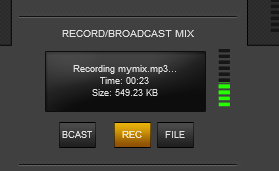
The Inputs of the DDJ-RR (CH1, CH2 and MIC Inputs) will be recorded if the PCMIX switcher at the rear panel is set to the ON position.
INPUTS, OUTPUTS & SETTINGS
The DDJ-RR offers 2 stereo Inputs (connections at the rear panel CH1 & CH2) that can be used with any analogue source and can be routed either directly to the software or the Master Output depending on the PCMIX switcher (rear side), along with a Microphone Input.
MICROPHONE
Connect a Microphone at the rear panel using the 1/4" MIC Input.
Hardware mode
When the PCMIX switch at the rear panel is set to OFF, the signal of the Microphone Input will be routed directly to the Master Output of the DDJ-RR, regardless if a software is running or not (Hardware routing). Adjust the volume output of the Microphone from the knob at the front panel.
The Microphone section of the MASTER panel of VirtualDJ will not affect the Microphone output, nor the Microphone will be recorded.
Software mode
When the PCMIX switch at the rear panel is set to ON, the signal of the Microphone Input will be routed to the software via the USB audio interface (Software routing).
The Microphone section of the MASTER panel of VirtualDJ will affect the Microphone output, and the Microphone will be recorded as well.
The volume output of the Microphone can be adjusted from both the Microphones Volume knob at the front panel of the DDJ-RR and the Mic Volume knob of the VirtualDJ GUI.
The Microphone needs to be turned on from the MIC ON button in the MASTER panel of the VirtualDJ GUI
In this mode (PCMIX to ON), the Microphone can be assigned to a VirtualDJ deck and offer the ability to apply Effects on the Microphone as well. You will need to assign the action deck 4 linein 'mic' to a keyboard key or a controller/custom button (can use a different deck number too).
INPUTS
Connect auxiliary media sources like CD Players, MP3 Players, turntables etc to any of the 2 available Inputs CH1 and CH2. Depending on the type of the source, the switcher LINE/PHONO needs to be set to the correct position (the PHONO option offers a pre-amp altenuator)
The signal of the Input Channels can be routed either directly to the Master Output or the DJ Application, depending on the PCMIX switcher position. The default audio configuration of the DDJ-RR includes the Line Ins, but they will not be used if the unit is set to Hardware mode (PCMIX to OFF)
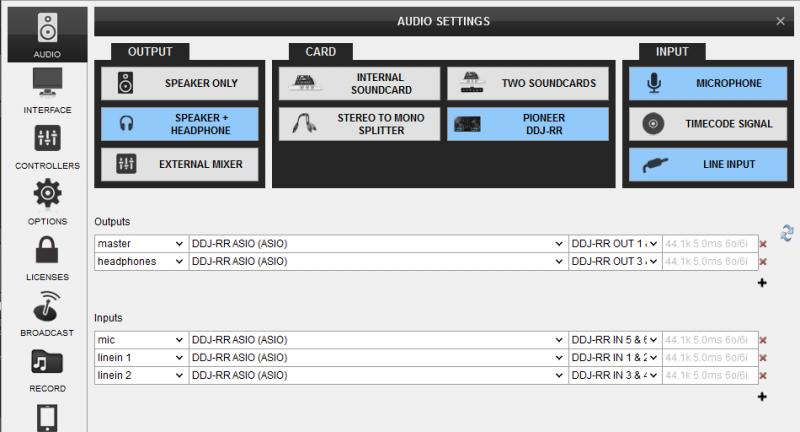
Hardware Mixer mode
When the PCMIX switcher is set to OFF, the Input channels are directly routed to the Master Output, regardless if the unit is connected to a computer via USB or not. This mode is mostly used for cases where an auxiliary source is used as a backup solution in case of a computer failure.
Note that the EQ and the Filter knobs will not affect the input sound, nor the Inputs can be controlled by the Deck sides of the DDJ-RR when the DECK SELECT switcher at the top panel are set to PHONO/LINE
When the PCMIX is set to OFF, the Inputs cannot be used by VirtualDJ, despite the fact that those are available in the default Audio configuration of the unit.
Software Mixer mode
When the PCMIX switcher is set to ON, the Input channels are directly routed to USB interface, and the audio configuration of VirtualDJ needs to be adjusted in order those Inputs to be controlled by the application.
This mode is mostly used for Timecode Control (DVS) or when the software needs to control the Inputs (e.g. when you need to sync an auxiliary source with a software Deck or to record AUX sources along with your software mix)
In this mode, the Inputs will be assigned to Decks 3 and 4 automatically, each time the DECK SELECTOR switches are set to PHONO/LINE position.
TIMECODES
In order Timecode Control (DVS) to be used, such as Timecode Vinyls or CDs, you will need to ..
- Connect your Timecode sources (Turntables or CD Players with Timecode signal) to the Input channels CH1 and CH2 at the rear panel and set the switcher LINE/PHONO to the appropriate position depending on the type of the source.
Note that both Inputs are set to the same LINE/PHONO position, so a combination of a turntable and a CD player is not possible (or rather not suggested) - Open VirtualDJ Settings and head to the AUDIO tab.
- Click on the TIMECODE SIGNAL button at the top-right of the window, so that 2 Timecode lines are automatically added to the audio configuration as per the following image. It is strongly suggested to remove the Linein lines from the audio configuration by clicking on the LINE INPUT button (line ins are included in the audio configuration by default)
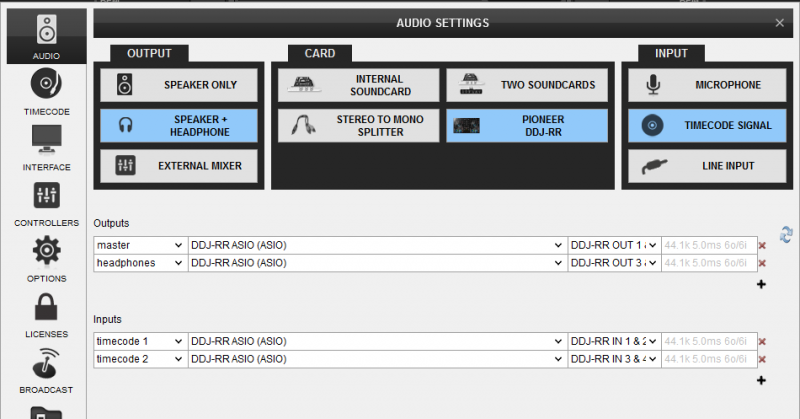
- Click to APPLY
When the Timecodes lines are included in the Audio configuration, the TIMECODE panels will appear on the VirtualDJ GUI. Click on those buttons to activate Timecode control to any of the left or right decks.
Rekordbox mode
The DDJ-RR offers 2 function modes. VirtualDJ will operate on both modes, but since some of the features are not available in both modes, it is strongly advised to set the unit to the Rekordbox mode (set by default).
In order to change/verify the selected mode ...
- Power off DDJ-RR
- While both left PLAY and left SYNC buttons are held, power on the DDJ-RR and then release the buttons. The unit should enter the UTILITIES mode.
- Make sure the MASTER TEMPO button on the left side of the DDJ-RR is turned off (Rekordbox mode)
- Power cycle the unit
BOOTH OUTPUT
The Pioneer DDJ-RR has a dedicated Channel for the Booth Output, which is not part of the pre-defined audio configuration. In case you need to use the Booth Output, you will need to manually add a Booth line in the audio setup as shown in the image below
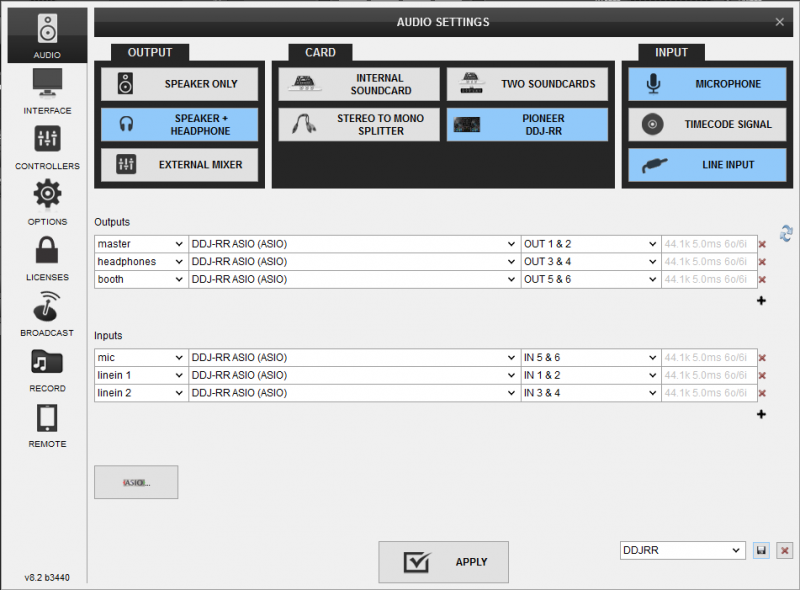
DDJ-RR Utilities Settings
The DDJ-RR offers a variety of Hardware settings via it's special firmware and VirtualDJ offers the ability to adjust most of them, through 2 special Pad modes (available when the DDJ-RR is connected and set to Rekordbox mode)
How to:
- Make sure the default GUI of VirtualDJ is used (or any other custom one which offers Pads controls)
- Click on the Pads page select button on either deck and select either the RR-JogLeds or the RR-Settings page.
- Place mouse over the Pads to read the Tooltip and help you with the assigned functionality
- Use the pads from either the GUI or the DDJ-RR to turn its assigned setting on/off.
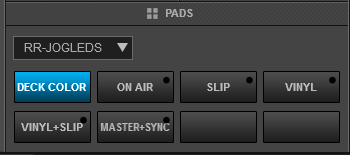
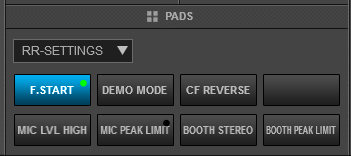
RR-JogLeds pad page
This Pads page offers the ability to select the behavior of the Jogwheel Led of the DDJ-RR
- DECK COLOR : When this option is selected, the Jogwheel Led of each deck of the DDJ-RR will get the color depending on the selected Left/right deck (Blue for Deck 1, Red for Deck 2, Green for Deck 3 and orange for Deck 4)
- ONAIR. When this option is selected, the Jogwheel Led of each deck on the DDJ-RR will get a green color is the coresponding deck is audible in the Master Output (On Air) and will be turned off when not.
- SLIP. When this option is selected, the Jogwheel Led of each deck of the DDJ-RR will get a red color when the Slip mode is enabled and blink red when Slip is active
- VINYL. When this option is selected, the Jogwheel Led of each deck of the DDJ-RR will get a blue color when the Vinyl mode is enabled and will be turned Off when the CD/Bend mode is selected (Vinyl mode off)
- VINYL+SLIP. When this option is selected, the Jogwheel Led of each deck of the DDJ-RR will get a red color when the Slip mode is enabled and blink red when Slip is active. When Slip mode is disabled, the Jogwheel Led of each deck of the DDJ-RR will get a blue color when the Vinyl mode is enabled and will be turned Off when the CD/Bend mode is selected (Vinyl mode off).
- MASTER & SYNC When this option is selected the Led of the Jogwheel will get an orange color when the Deck is set as Master-Deck and white when both decks are playing and the Deck is synced to other one but is not Master-Deck.
RR-Settings pad page
This Pads page offers the ability to adjust/select a few important features of the DDJ-RR
- F. START. When this setting is enabled, SHIFT+VOLUME faders will provide Fader Start/Stop functionality
- DEMO MODE. When this setting is enabled, the DDJ-RR will enter Demo mode after 10 mins of no usage.
- CF REVERSE. When this setting is enabled, the Crossfader will be reversed. Note that this is an additional Hardware setting. The Crossfader can be also reversed through VirtualDJ Settings or Mixer mode menu (available in the 4 decks VirtualDJ GUI)
- MIC LEVEL HIGH. Change this setting when the Microphone output is too low or too high, even after adjusting it with the Mic Volume knob at the front panel. When enabled, it sets the Microphone sound level to low and when disabled it sets to the high level.
- MIC PEAK LIMIT. When enabled, prevent unpleasant digital clipping of the Microphone Inputs
- BOOTH STEREO. Switches the setting for the Booth Output between Mono and Stereo.
- BOOTH PEAK LIMIT. When enabled, prevents unpleasant digital clipping on the Booth Output
